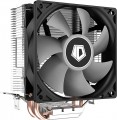Fan thickness
This parameter must be considered in the context of whether the fan will fit into the computer case. Standard case fans are available in the order of 25 mm in thickness. Low-profile coolers with a thickness of about 15 mm are designed for small-sized cases, where saving space is extremely important. Fans of large thickness (30-40 mm) boast high cooling efficiency due to the increased impeller dimensions. However, they are noisier than standard models at the same speed and do not always fit into the case normally, sometimes touching other components.
replaceable
The ability
to replace a regular fan by the user himself — without contacting a service centre or repairmen. The maximum that may be required for such a procedure is the simplest tools like a screwdriver; sometimes they are even initially included in the cooling system kit.
The fan, as the most mobile part of any cooling system, is more prone to breakdowns and failures than other parts. In cases like this, it's cheaper (and often smarter) to replace just that part rather than buying a whole new system. Also, if desired, you can change a working fan — for example, to a more powerful or less noisy one.
Socket
Socket type - socket for CPU - with which the corresponding cooling system is compatible.
Different sockets differ not only in compatibility with a particular CPU, but also in the configuration of the seat for the cooling system. So, when purchasing a processor cooling system separately, you should make sure that it is compatible with the socket. Nowadays, solutions are produced mainly for the following types of sockets:
AMD AM2/AM3/FM1/FM2,
AMD AM4,
AMD AM5,
AMD TR4/TRX4,
Intel 775,
Intel 1150,
Intel 1155/1156,
Intel 1366,
Intel 2011/2011
v3,
Intel 2066,
Intel 1151/1151 v2,
Intel 1200,
Intel 1700.
Starting voltage
The starting voltage of the fan installed in the cooling system. In fact, this is the smallest value necessary for stable operation of the fan — if the voltage is too low, it simply “will not start”. Note that this parameter is relevant mainly for rather specific tasks — for example, installing a fan in a power supply unit with a direct connection to the PSU, or choosing an external controller to control the rotation speed. When connected through standard power connectors, you can not pay much attention to the starting voltage.

